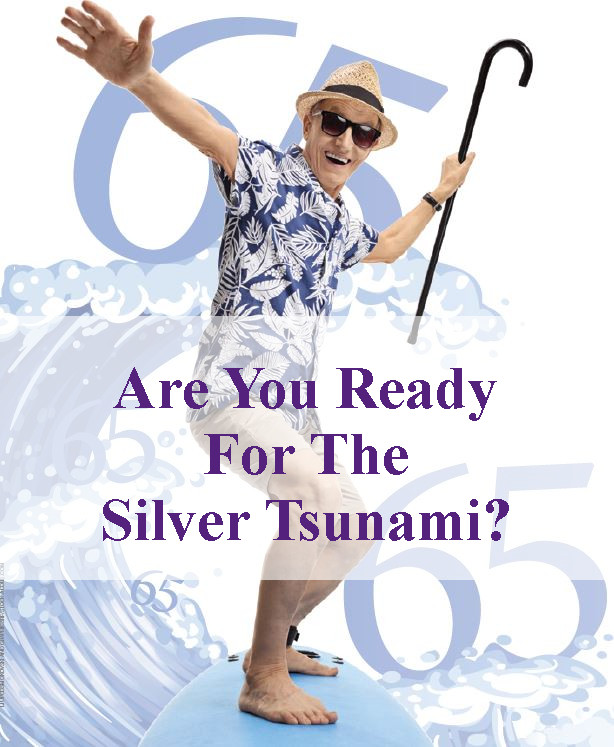I take pride in being a baby boomer, one of those born between 1945 – 1964, the largest generation in U.S. history. As Roger Daltry, of The Who rock group, sang in the song My Generation: ‘Hope I die before I get old’, we boomers expect excellence in quality of life.

In 2010, 13.1% of the American population was 65 and older; in 2030, that figure will be 21.4%. And by 2050, there will be more Americans 65+ than children younger than age 15. As of 2011, the first of the 78 million baby boomers turned 65. In 10 years those boomers will be 75, and in 10 more, age 85. For the next 19 years, nearly 10,000 people a day will turn 65. And that doesn’t include the demographic that reached 65 before 2011.1 Businesses such as McDonald’s and CVS stores are widening their aisles and entrances and lowering their shelves to make allowances for seniors ease of shopping. Baby boomers are being referred to by retailers as the ‘Silver Tsunami’.
According to the American Association of Retired Persons magazine, (AARP):
Seniors are the fastest growing population to embrace technology spending $7 billion annually online and their income per capita is 26% higher than the national average. Some other facts about today’s seniors:
- They control 70% of all wealth in the US
- They have more than $2 trillion in annual income
- They have more disposable income than any other age group
- They would be lost with their computers & the internet (84%)
- They purchase 41% of new cars
- They spend 74% more on vacations than any other age group
- They exercise – 16 million say they exercise at least 3 times a week
- They enjoy gambling and are willing to travel to do so
- They spend more on groceries, health products and leisure
- They buy 51% of all over the counter drugs
- The purchase 74% of all prescription drugs
- They purchase 25% of all toys
- They account for 60% of all healthcare spending
- 49% cite health and wellness as their primary concern
- 52% report no physical activity
- 35% report moderate physical activity 12 X a month
- 13% say they’re in excellent health
- 72% have one or more chronic diseases
- 43% have high blood pressure
- 24% have a walking disability
- 16% have diabetes
In our Western culture, recent research shows that 80% of all physician office visits are stress related. We see a rise in diseases that are worsened by trauma, stress, lifestyle, diet, repressed emotions and genetics. The mind-body connection holds true; depression and worry cause illness in the body, and a calm and cheerful mind will promote health and wellness.
Armed with the knowledge of the information ‘super highway’ and resources of disposable income, are today’s U.S. seniors reaping the benefits of health and wellness? Shouldn’t seniors be enjoying our pre-retirement and retirement years actively traveling, pursuing hobbies and volunteering while in their optimum level of health in the country famed to have the highest quality healthcare system and highest standard of living in the world? I hear the mantra, “50 is the new 40; 60 is the new 50; 70 is the new 60”. Are we defining healthy aging or are we in denial?
20 years ago I quit smoking and began exercising regularly. My siblings were quite athletic. I was the uncoordinated doofus and had the most horrendous of all middle school P.E. teachers, Mrs. Cummings, who favored the girls with athletic ability and punished those of us who didn’t. During track events I kicked over every hurdle and ducked when the ball came my way in softball or basketball practice. There wasn’t a sport I had any interest in except swimming and I was mediocre; both my sisters won numerous ribbons in individual and team races. So sports in general never held the appeal that cooking, picking flowers, music, reading or walking in the woods did for me.
Discovering the endorphin rush of exercise at middle age was exhilarating! Finally figuring out that dance, yoga, gardening, walking on the beach or in the woods was the path to fitness added a completely new dimension to my life. Since midlife is also when the ‘spare tire’ to your waist usually appears, I’ve found that exercise is as essential to maintaining a healthy weight as massage is for maintaining my emotional well-being.
The popularity of complementary and alternative medicine (CAM) in the United States is well documented. CAM is used by an estimated 40% of the adult population at an annual out-of-pocket cost of $33.9 billion. Chronic diseases account for most health care utilization and expenditures in middle-aged and older populations, with joint and back pain–related conditions being among the most prevalent. The prevalence of chronic pain reported in the United States is 30.7%, and the prevalence is higher in women and among persons of advancing age. Sixty percent to 75% of CAM expenditures are for manipulative or body-based therapies, including massage. Massage was the CAM therapy used by the highest proportion of adults to treat functional limitation (53.4%); most used massage to treat back/neck pain, followed by arthritis/rheumatism. On the basis of a systematic review of non-pharmacologic therapies for treatment of chronic back pain, the American Pain Society and American College of Physicians jointly recommended in a practice guideline that clinicians consider several CAM therapies, including massage, for patients who don’t respond to self-care options.
Similarly evidence-based practice guidelines in oncology have recommended massage for relief of pain and anxiety. Clinical acceptance of massage for these indications in practice guidelines is believed to account for the large increase (55.7%) in massage use observed from 2002 to 2007.
Chronic back pain is thought to affect about 50 million adults in the U.S., with older adults particularly at risk. Many people with back pain are prescribed opioids, powerful painkillers that are frequently utilized as next-step therapy if back pain doesn’t respond to other medications.3
However, a recent study suggests that opiods are less effective in one particular subset of patients with back pain- those who also suffer from depression and anxiety. The same data also indicate that depression or anxiety alongside back pain may increase the risk for opioid abuse.
“High levels of depression and anxiety are common in patients with chronic lower back pain,” says study author Ajay Wasan, M.D., professor of anesthesiology and psychiatry at the University of Pittsburg School of Medicine. There is abundant evidence that opioids can be useful to people suffering from chronic pain, but the drugs come with a serious risk of dependency; another recent study (Mayo Clinic Proceedings, July 2015) suggests that nearly 25 percent of patients with an opioid prescription will end up using the drugs long term. Seniors are no less immune to opioid dependency as are other age groups- but that isn’t all they have to worry about: Previous research suggests that older adults using opioids are more than 4 times more likely to suffer a fall with a fracture than non-opioid users.3
According to IMS Health, which tracks drug dispensing for the U.S. government, 55 million opioid prescriptions were written in 2013 for people age 65 and older. But because of the risks associated with these drugs, Dr. Wasan recommends alternatives – for example, non-narcotic pain medications and non-pharmaceutical therapies- to manage chronic pain whenever possible.3
According to the October 2015 issue of ‘Mind & Memory’ from Duke Medicine:
Try non-pharmaceutical approaches to ease back pain:
- Adopt good body mechanics: Don’t slump when sitting, and when lifting, bend at the knees and not at the waist.
- Strengthen your core muscles, which stabilize and support the spine. A physical therapist or trainer can show you the most effective exercises to strengthen them. Or, investigate yoga or Pilates, since both involve controlled movements that benefit core muscles.
- Consider massage. A 2011 study suggested that people with back pain report improved symptoms and better function with massage therapy.
According to the American Academy of Orthopedic Surgeons:
There is a 673% predicted increase in knee replacements among boomers by 2030 and a 174% increase in hip replacements.
Being diagnosed with osteoarthritis in my neck, shoulders and hips in my 50’s was frightening to say the least. Because I have access to massage therapy, and take full advantage of it, my pain management is better controlled than most arthritic patients. Weight training and swimming became more important to my fitness since I couldn’t walk, dance or garden without pain. Since my massage practice is my main source of income I consulted with my orthopedist who recommended surgery. I then got 2 more opinions from 2 other orthopedists; they all concurred that a total hip replacement was in my future. ”When should I schedule the surgery?’’ the answer was, “When you can’t stand the pain any longer.’’ My mother had both her arthritic hips replaced in her 70’s and I remember her saying after her first hip surgery ,”Ï wish I had done that 10 years ago.’’
So, since Mother knows best, I took her advice and had the surgery in October, 2015, at age 60. Because I prepared for the surgery 6 months in advance by weight training, strengthening my core muscles and receiving regular massage, I’m happy to report that in November of 2016 I can garden, hike, kayak and walk pain free!
Sources:
Population Division, U.S. Census Bureau 65 and Older Population Grows Rapidly as Baby Boomers Age 25, June 2020 Release Number CB20-99
O’Rourke, P.J. “2014 The Year Of The Boomer.” AARP, 2014
Journal Complementary and Alternative Medicine 20(10): 2014 Oct 1, 2014 pgs. 792-799
Blazer, Dan. “Duke Medicine: Health News.” Resistance Exercise Fights Depression, vol. 25, no. 4, Apr. 2019, pp. 1–2., https://doi.org/10.2307/j.ctt1pk86dk.36.
Scully, Ryan D.; Kappa, Jason E.; Melvin, J. Stuart. Journal of the American Academy of Orthopaedic Surgeons “Outpatient”-Same-calendar-day Discharge Hip and Knee Arthroplasty: 28(20):e900-e909, October 15, 2020.
This article was originally published in the FSMTA June, 2016 Newsletter – republished with permission

